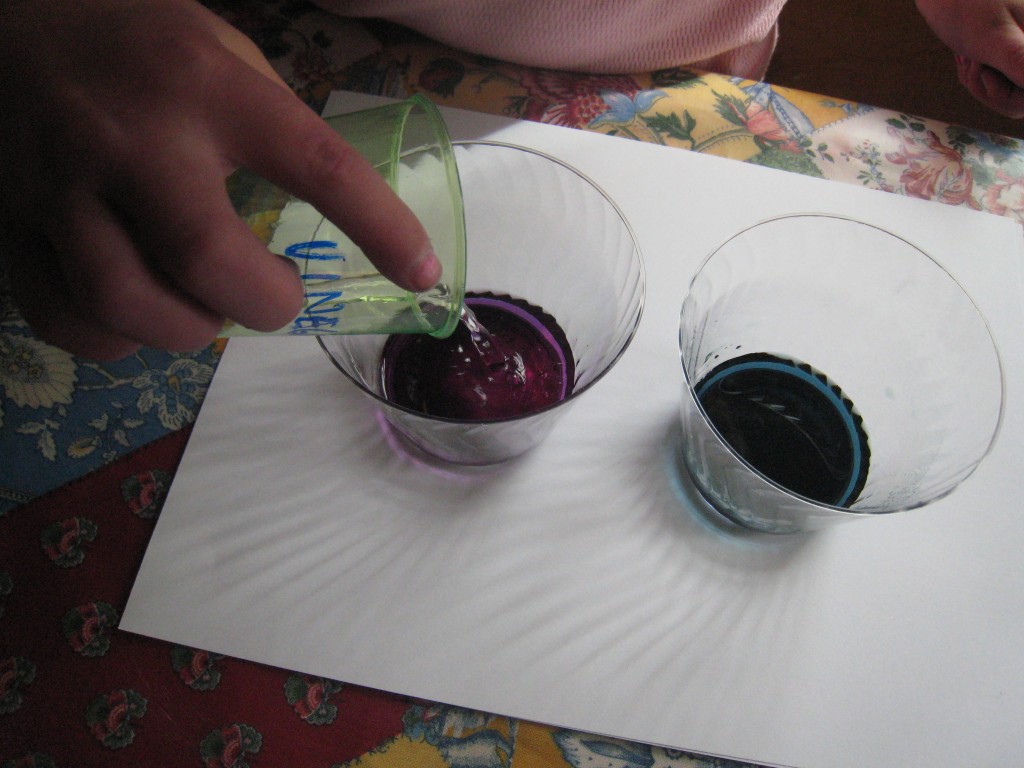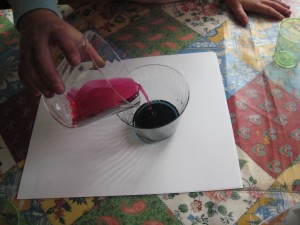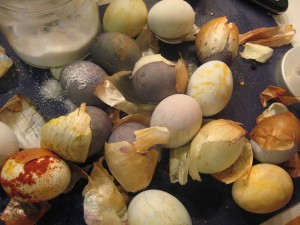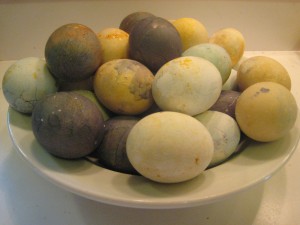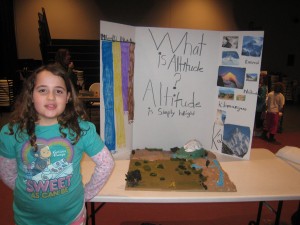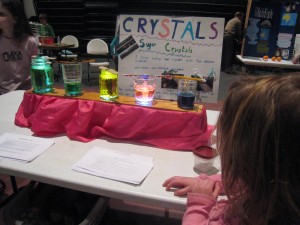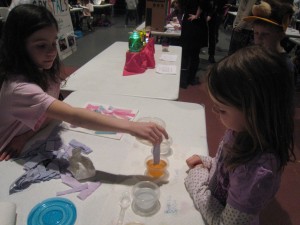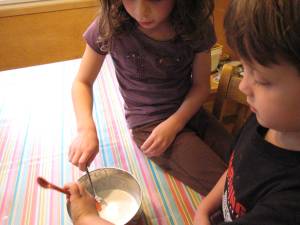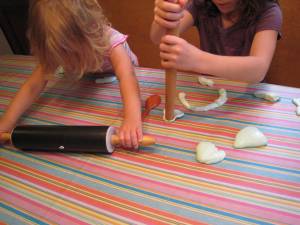Category:Uncategorized’
Math and Science Family Fun Fair at the University of Minnesota
- by KitchenPantryScientist
On Kare11 this morning, a University of Minnesota professor did a screaming gummy bear experiment to publicize tomorrow’s (Nov. 13th) Math and Science Family Fun Fair. Watch the video on the right-hand side of their website to see what happens when a gummy bear releases all of its chemical energy!
They’ll have lots of fun science demonstrations for all ages and It would be a great activity for the cold, snowy day they’re predicting tomorrow.
The event is this Saturday, 10 a.m. – 4 p.m. at the University of Minnesota’s Coffman Memorial Union. Visit cse.umn.edu/funfair for more information.
Cholera- A Pretty Name for an Ugly Disease
- by KitchenPantryScientist
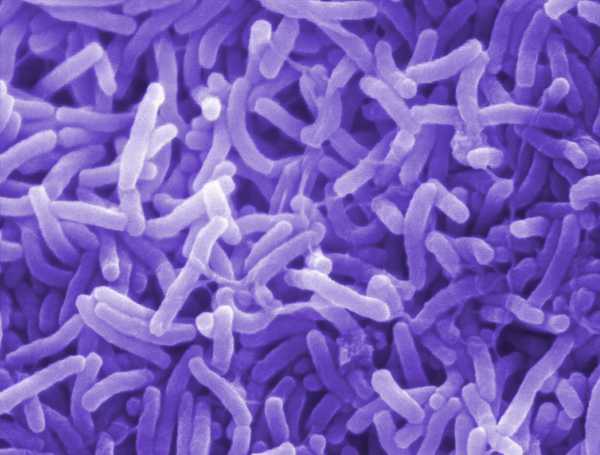
Vibrio cholerae bacteria
Picture yourself lying on a dirty cot with a hole cut out under you to collect buckets full of unstoppable diarrhea. Now imagine your child lying there. Finally, pretend you are not one of the lucky ones lying on a cholera cot in a hospital, but are lined up outside in the street, waiting for help.
Cholera is an ugly disease.
The bacteria Vibrio cholerae makes a toxin that shreds the intestinal lining, causing white flecks that look like rice to be passed in huge volumes of watery diarrhea. In hospitals, these “rice water stools” are collected and measured in buckets so body fluids can be replaced. Adults can lose up to 22 liters a day while battling this devastating infection. Without fluid and electrolyte replacement, most victims die from shock.
Lucky patients that recover often still carry the bacteria and can infect others. They can even re-infect themselves.
Cholera bacteria can survive outside the human body in water. They do especially well in dirty water. Unsanitary conditions are breeding grounds for Vibrio cholerae.
I read this morning in the New York Times that cholera has spread from the Hatian countryside to the crowded, unsanitary camps of the earthquake survivors in Port-au-Prince. The camps don’t have clean toilets and are often flooded when it rains. Over a million people live in filth and poverty. According to the article, health officials predict that over 270,000 people could get sick with cholera over the next few years.
People like you, and me, and our kids.
What can you do to help? Support aid organizations that are mobilizing to get clean water, water purification supplies, and medical supplies to Haiti. Once the supplies arrive though, it’s up to the Hatian government to make sure workers are able to get them to the people most in need. Let’s hope they do.
Magic Potion
- by KitchenPantryScientist
Making magic potion is simple! Chop a head of red cabbage into small pieces and add it to a pan with enough water to cover it. Boil the cabbage uncovered for about 15 minutes, stirring occasionally, let it cool, and strain the juice into a jar or bowl. (Save the cooked cabbage for dinner.)
If you want to avoid the stove, chop half a head of red cabbage and blend it with about 3 cups of water. Strain the liquid through a colander and then through a coffee filter in a plastic bag with one corner cut off. Blended cabbage juice makes longer-lasting bubbles and turns a slightly brighter shade of blue!
Now, pour about 1/4 cup of the cabbage juice, or “magic potion” into two clear glasses or bowls and set them on a white piece of paper (so you can watch the color change.)
Try adding a Tablespoon of baking soda to one glass of potion. What happens?
To the second cup of potion, add a few Tablespoons of vinegar or lemon juice. Notice anything different?
Finally, mix the two cups of potion together.
Why did the color change when you added two different chemicals to the magic potion? Everything in our world is made of very tiny pieces called atoms. Atoms are so small that if you blow up a balloon, it will contain about a hundred billion billion atoms of the gases that make up air. Atoms are often bonded to other atoms to form a group of linked atoms called a molecule.
Acids usually dissolve in water to form free-floating hydrogen atoms. Bases are the opposite and take up free hydrogen atoms. The molecules in the cabbage juice magic potion change when exposed to an acid or base, making the potion change color. Vinegar is an acid, which turns the potion pink and baking soda is a base, which turns it blue or green.
When you mix the vinegar potion and baking soda potion together, a chemical reaction occurs and you make Carbon Dioxide gas. That’s why you see bubbles!
Try adding some other liquids to your magic potion. Can you tell whether they are acids or bases?
Here’s a short video that shows you exactly how to do the experiment!
Happy experimenting!
Science Camp
- by KitchenPantryScientist
The dog days of August are here. It’s hot and humid and summer sports and activities are coming to an end, which can only mean one thing: bored kids. I know that boredom is good and sparks creativity, but sometimes it’s nice to have an activity planned to break up the day.
My kids have nothing scheduled in the afternoons this week, so we’re going to do an impromptu science camp. It won’t be elaborate, well-planned or even all that time-consuming. We’ll just find a few easy projects that we can do using stuff we already have. (There will be no trips to the store to buys special ingredients.) It may be as simple as taking a walk to the park with notebooks to count how many different kinds of trees we can find. We’ll see what happens and I’ll report on what we do, beginning tomorrow!
Why not have a little science camp of your own, even just for an afternoon? There are lots of easy projects listed in my archives under chemistry, physics and biology. I’d love to hear what you tried!
It’s Been in the Refrigerator How Long?
- by KitchenPantryScientist
I just stumbled across this great blog post on Babble.com with a link to a website devoted to food safety called StillTasty-Your Ultimate Shelf Life Guide. It’s a great resource with information on how long you can store and eat every kind of food imaginable!
For example, raw eggs, in the shell are good for 3-5 weeks after purchase, even if they’re past the printed expiration date, as long as they’re refrigerated.
I’m putting StillTasty on the “shelf” with my other favorite websites.
Eat well. Stay well.
Butterfly Season
- by KitchenPantryScientist
met⋅a⋅mor⋅pho⋅sis
| Biology. a profound change in form from one stage to the next in the life history of an organism, as from the caterpillar to the pupa and from the pupa to the adult butterfly |
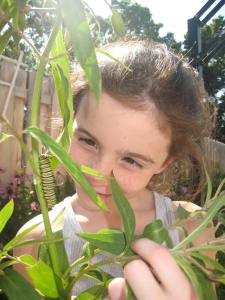
There are few things more magical than watching a caterpillar turn into a chrysalis and then a butterfly. It’s the beginning of butterfly season, and soon you’ll be able to find monarch caterpillars on milkweed. Just this morning, I spotted a Tiger Swallowtail butterfly by the lake. Not only is it fascinating to observe metamorphosis, it is a great opportunity to create some fantastic artwork for your science notebook!
When the weeds in your area start to get big, take a trip to a park, or a farm, or even a weedy lot and search for some milkweed. (See photo below.) Look carefully on the plants, and there’s a good chance you’ll find a Monarch caterpillar like the one my daughter is watching at in the photo at the top of this page. If you find another type of caterpillar, take whatever plant you find it on with you as food. Carefully take the caterpillar and plenty of milkweed and place them in a large see-through container. We used an old plastic pretzel container, but a large jar or Tupperware container would work too. Just be sure to punch air holes! I put the milkweed in a little vase with water to keep it alive, but a friend told me you can put the leaves between damp paper towels and keep them in the fridge, getting them out when you need fresh ones.

milkweed
Last year, I planted butterfly weed, a type of milkweed, in our garden in hopes of getting caterpillars right in our own backyard and it worked! Just plant milkweed or other butterfly-friendly plants this spring and summer if you want a butterfly gardenof your own. It’s a great way to help the butterfly population. Swallowtail caterpillars like dill and I’ve seen caterpillars in my parsley too!
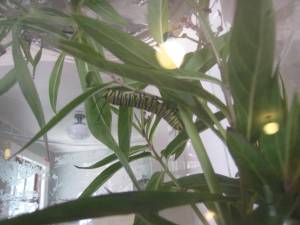
Once you have your caterpillar, all you have to do is make sure it has plenty of leaves to eat. Occasionally, you’ll have to dump out the caterpillar poop, of which there is a surprising amount. Get out your science notebook or just some paper and draw the caterpillar and the milkweed. When it is ready to form a chrysalis, the caterpillar will hang upside down and look like the letter J. Draw the chrysalis, and finally, the beautiful butterfly that emerges! Keep track of how the caterpillar is growing and how long it spends as a crysallis before hatching.
A few years ago, my kids and I were lucky enough to see the caterpillar turn into a chrysalis. It only takes a few seconds and is easy to miss, but it is truely amazing. If you’re lucky and patient, you may see it too. Here is a link to a short video showing what happens.
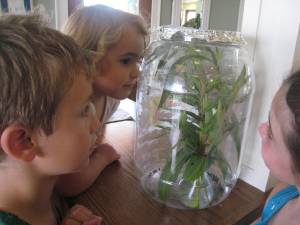
There’s nothing quite like taking the lid off your butterfly house and watching a Monarch soar away into the sky.
Spectacular Eggsperiment- Natural Dyes
- by KitchenPantryScientist
Make your own egg dye! Boil colorful fruit, vegetables and spices with 4-8 cups water and a few Tbs. of white vinegar. When the water is boiling, add raw eggs and boil for 10 minutes. The pigment in the fruits and veggies will be absorbed by the egg’s porous surface as they cook. Let the eggs sit in the dye until cool. Then, wrap the wet eggs in onion skins or rub with paprika for yellow. We had the best luck with blueberries, curry and red cabbage. Experiment to see what makes the best colors! What worked best for you? Coffee? Tea? rhubarb? Don’t forget to eat your creations. Hard-boiled eggs make a great snack!
Imagination Fair
- by KitchenPantryScientist
Our school’s Imagination Fair is one of my kids’ favorite events of the year. I love it too. One of the best things about this gathering is that it is not a competition. I also love that there are no rules and guidelines. My kids spend their days following rules and competing against others, whether it is in school or in sports. For the Imagination Fair, kids simply create, demonstrate, or show off something that interests them and then have a great time walking around and checking out everyone else’s projects.
Sugar cube castles towered over posters about magnets, and jars full of home-grown crystals stood next to Lego creations. There were plastic sharks wired to foam board, a cardboard reproduction of the Olympics half-pipe and a poster about money of the world. You could pet a bunny or “test your knowledge” to win a sucker. My four-year old especially loved the circut table, where one boy had inventions that spun and beeped when you made electrical connections.
I’m thinking of putting an “Imagination Fair” together this summer, in my back yard, for the neighborhood kids. What better way to let kids be kids?
We made it!
- by KitchenPantryScientist
WooooooHooooo! Unplannedcooking aand I made it onto the I Can’t Believe it’s Not Butter commercial during American Idol last night! (You can watch it by clicking here. )
You can view our entire video on the website http://www.turnthetubaround.com by going to the contest and then the gallery. Starting Jan.19th (next Tues.), you’ll be able to vote for us. By voting, you are entered in the I Can’t Believe it’s not Butter Sweepstakes and have a chance to win lots of great prizes. Thanks to Hot Mama for letting us shoot most of the commercial at their store!
Mad Scientist’s Green Slime
- by KitchenPantryScientist
What could be more fun than creating your own green slime to play with? It’s easy to synthesize your own green goo using only Elmer’s glue (the non-washable kind), Borax (found in the laundry detergent section of most stores), green food coloring and water.
In a bowl, have your child mix together about 1/3 cup glue and 1/3 cup water with a spoon or Popsicle stick. These measurements don’t have to be exact. Add a few drops of green food coloring and mix well.
To make the Borax solution, add around a cup of water to a jar. To the water, add about a Tablespoon of Borax. Have your child shake the jar to dissolve as much of the Borax as possible. You are making what is called a saturated solution, so it may not all dissolve! Don’t worry, it will work just fine.
Have your child add about a teaspoon at a time of the Borax solution to the glue/water mix. After each addition, have them stir the mixture together. You should see long strings begin to form and stick together. Keep adding Borax until the mixture doesn’t feel gluey any more. It will form sort of a shiny playdough-like substance. If you add too much Borax solution, it will feel wet. You should be able to just knead it a little to absorb the extra water! The slime is not toxic, but Borax is soap, so don’t let your kids eat it!
I am a biologist and not a chemist, but here is the science, as I understand it.
Mixing Elmer’s glue with water forms a substance called a polymer, which is a long chain of molecules. (A molecule is the smallest amount of a specific chemical substance that can exist alone, like H2O, a single water molecule). The polymer formed by water and glue is called polyvinyl acetate.
The Borax solution (sodium tetraborate) is a cross-linking substance that makes the polymer chains stick together. As more and more chains stick together, they can’t move around and the goo gets thicker and thicker. Eventually, all the chains are bound together and no more Borax solution can be incorporated.
You can store the slime in plastic bags. If you want to make a larger batch, just remember to mix equal amounts of glue and water and add as much Borax solution as needed.
To make your child feel like a “real” scientist, find an old, button up shirt for your child to use as his or her “lab coat”. It’s fun and will protect their clothes. You could even try to find some old safety goggles in your garage for your child to wear, although the ingredients for this project are relatively safe. (Very young children should always be supervised while doing science projects.)
Have fun!
